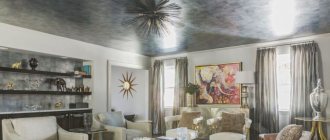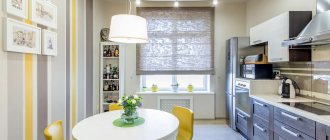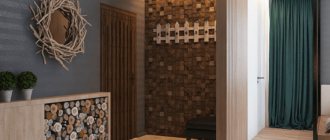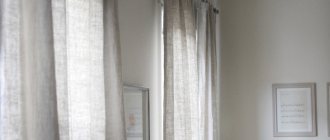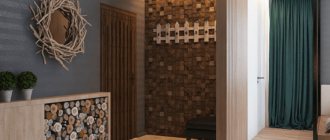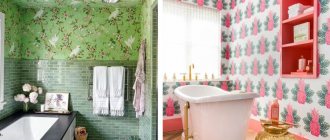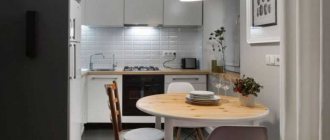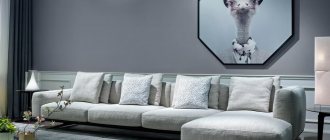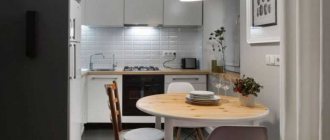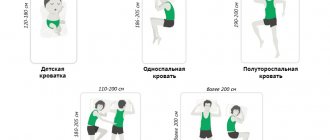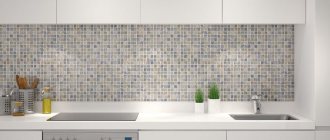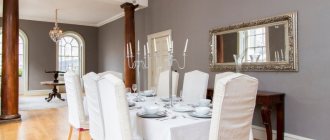What it is?
Wallpaper with plaster imitates covering a wall with plaster. Color, texture and effects can be different, which allows you to create a completely unusual design. The coating material can have a different composition, is easier to apply than real plaster, and it also has a lower cost.
Compound
The coating, which imitates plaster, has a two-layer structure consisting of a base and a top layer. The main layer is paper or non-woven, the top layer is acrylic, paper (duplex) or PVC. The relief texture for paper and non-woven wallpaper is obtained by embossing; with this manufacturing method, the material is characterized by increased strength and does not stretch when wetted with glue. The relief texture for acrylic canvas is obtained by applying foamed acrylic to the surface; the pattern is applied dotted.
Advantages and disadvantages
Coatings imitating plaster undoubtedly look impressive, but, like any other material, it has its advantages and disadvantages. After considering them, you can decide on the ideal finishing method for yourself.
| Advantages | Flaws |
| Service life up to 15 years. For wallpaper this is a long time, although real plaster lasts longer. | Wallpaper with a paper composition is easily damaged and has a short service life. |
| The surface of wallpaper, unlike plaster, is warm. Suitable for decorating a children's room or bedroom. | Vinyl wallpaper practically does not allow air to pass through. |
| Wallpaper hides unevenness and minor defects in the walls. | Before applying wallpaper, it is necessary to prepare the walls, level and prime them. |
| The cost is relatively low compared to the original plaster. | |
| The material is easy to handle. Wallpaper is applied and removed much easier than real plaster. |
Which is better: wallpaper or decorative plaster
Before you start decorating the walls, you need to have a clear idea of the final result. Then you can understand exactly what material should be used. This issue must be resolved long before the start of repair work. Most often, a difficult choice is between wallpaper and plaster.
The choice between wallpaper or decorative plaster should be based on the personal preferences and budget of the apartment owner
In order not to make a mistake in making the right choice, you should weigh the pros and cons by comparing the materials with each other:
- Durability is considered the main criterion in such a difficult choice. Plaster can last from 30-60 years. The service life depends on the composition. Wallpaper sheets can last up to 10 years, but may significantly lose their original appearance. There are interesting types of wallpaper that can last a long time, these are liquid and textile.
- Price is a rather controversial criterion. On average, finishing with plaster can cost much less than finishing with wallpaper. It all depends on the type of material chosen and the method of applying it to the wall.
- The energy component is the cost of effort and time; this is the final criterion by which you should make your choice. Wallpapering requires lengthy preparation of the wall surface, which significantly increases the time and effort spent. Plaster has a huge advantage over wallpaper because it does not require additional wall preparation.
Related article: Living room ceiling design trends
If you choose by appearance, then it all depends on the main idea of the interior design. Decorative plaster has many color shades and different textures.
Wallpaper has original designs that cannot be recreated with plaster. The choice of material depends on the preferences of the owners.
Types and characteristics
Wallpaper for plaster, like any other, can have a different composition. By type they can be divided into non-woven, vinyl, paper and liquid. A variety of types allows you to choose the best option for the room.
Under textured plaster
The canvas has a relief pattern, with noticeable irregularities and roughness. The coating is similar to the original plaster, the images can have different effects, such as plastered stone or chaotic strokes. However, such wallpaper can quickly lose its presentable appearance in places of frequent contact with other objects, such as a hallway or children's room.
Under structural plaster
The canvases focus attention on the structural part, noticeable bulges and relief. Acrylic material is often chosen as structural wallpaper. On such coatings the structure is especially noticeable; the surface of the wall is soft, however, with frequent contact, it can wear off.
This material can be used for painting, thereby updating the design of the room.
Under Venetian plaster
The coating can have different effects: a shiny surface that will shimmer in the light, the effect of a marble wall, otherwise known as Italian marble, or with elements of natural motifs. The material is wear-resistant, does not fade over time and comes in a wide variety of colors and patterns.
Read more about Venetian wallpaper.
Under silk plaster (liquid wallpaper)
The material initially has the form of a powder and is diluted with water. Liquid wallpaper does not have a uniform surface without joints, is easy to apply and, if necessary, you can replace the damaged fragment with a new one. Frequent contact with water may leave a mark. Compared to regular wallpaper, liquid wallpaper does not differ in such variety.
Under old plaster (aged)
Coverings with aged plaster look impressive in a loft interior. There are noticeable cracks on the surface that give the walls a noble antiquity.
The photo shows a living room-kitchen-living room in a loft style. The wall is decorated with wallpaper that resembles old plaster, with noticeable unevenness and a rough texture.
Types of wallpaper
The main varieties of this material, which can be similar to plasters, are made from non-woven, vinyl, paper and fiberglass structures. It is the canvases on these bases that have the best characteristics and convey the desired effect. Let's highlight each of them, weighing their pros and cons.
- Non-woven fabrics and their characteristics. This is a two-layer coating containing cellulose fibers; the base can be paper or non-woven. Models are also produced with the addition of vinyl. They are moisture resistant and washable. They are used in all rooms, including rooms with a high humidity threshold. Among them there are many options made in the style of decorative plaster, perfectly repeating the design and their relief. Their advantage is that they can be repainted many times, changing the tone and color. They have good throughput, which is necessary to maintain the internal microclimate of the space, so they are often glued in children's rooms and bedrooms. They are in the middle price category, among which there are budget options. They are glued with special glue, usually in vertical lines, exactly at the joint. During installation, the adhesive is applied only to the wall, leaving the canvas dry. Thanks to their density, they hide minor surface roughness, but require mandatory preparation of the walls, leveling and priming. An excellent alternative to plaster, as it can compete in aesthetics, ease of installation and product price, second only to strength and durability.
- Vinyl models. The foundation of the base can be paper and non-woven formations, a structure in two or three layers. They are distinguished by increased moisture resistance, durability and a variety of embossed appearance, in comparison with other rolled products. The texture differs in the types of different effects and relief texture options with convex shapes, divided into; foamed, silk-screened and flat types. Some are suitable for repainting, may have an adhesive base, and in order to glue them you need to soak them in warm water. They are divided by area of purpose, super-resistant models for kitchens and bathrooms, acrylic subtypes for dry spaces, etc. Their disadvantage is low vapor permeability and do not have breathability, so some of the fabrics in this series are not advisable for gluing in children's rooms. They cope well with aggressive climates, are washable, do not absorb odors, do not fade and are resistant to physical impact, and can be used in damp and unheated rooms. They are glued with glue for heavy wallpaper, successfully hide minor wall defects, and require surface preparation before installation. There are models with partial addition of vinyl, these are acrylic and silk-screen models, leaving pores for natural air penetration, which are practical for any decoration, but their strength is lower and among them there are non-moisture resistant fabrics. Vinyl wallpaper under decorative plaster naturally takes on a similar look.
- Paper models (duplex). They consist of two layers, which are combined during production with wet embossing, achieving the necessary strength and structural highlighting of the image. Some are covered with latex or acrylic (vinyl type) film, giving them moisture-resistant qualities and the ability to care for them with a damp cloth. They are less durable, and it is not advisable to glue them in rooms with high humidity and sudden temperature changes. Can be repainted several times. Their palette includes varieties that imitate plasters, flat or with fine relief. Simple paper sheets are also produced, they have the shortest service life, the lowest technical characteristics, but they are the cheapest, they can be considered for the bedroom and decorating a children's room.
- Fiberglass wallpaper, glass wallpaper. Some of their varieties can imitate plasters with a unique relief and texture effect. The relief is achieved by weaving thin glass threads in production, and different textures are formed depending on the yarn method. Many Venetian wallpapers are created on this material. There are varieties for reinforcing walls that need to be puttied and they are called fiberglass, and glass wallpaper, these are decorative relief models for painting or finished finishing products that have a finished decorative texture. They are distinguished by their particular strength and durability, washable, natural and breathable, with the possibility of repainting. Very dense and perfectly hide surface defects. Suitable for rooms with high humidity and frequent temperature fluctuations, they do not attract odors and are not afraid of ultraviolet radiation. But such coverage has a fairly high price.
Also read: What is better, decorative plaster or wallpaper? (liquid and roll)
Modern production has achieved great results. Hot stamping, foaming, yarn, photographic application of ornaments, spraying, give extraordinary effects. Wallpaper is not only beautiful, it is also fast, easy and reliable.
Photos in the interior of the rooms
In the kitchen
Imitating plaster in the kitchen can create a different mood. Depending on the chosen tone and furniture pieces, the design can suit any style. For example, a warm color of decoration and wooden furniture are suitable for classic and country style; a cool tone of wallpaper in combination with wood, metal or plastic will decorate a modern kitchen design.
It would be more appropriate to decorate the dining area with wallpaper, or protect the work area with protective glass. It will help avoid contamination and mechanical damage.
The photo shows a spacious kitchen in a classic style. The walls are decorated with wallpaper for plaster combined with brickwork.
In the corridor
In the corridor it is worth using a material with increased strength, that is, it is better to refuse paper sheets. Due to possible contact with shoes, outerwear and other items, it is better to choose a more practical type of wallpaper, such as vinyl.
Plaster combines well with real and artificial stone or brick. This finishing technique allows you to protect corners and the most vulnerable places.
In the living room
In the hall and living room, plaster can support a modern or classic design. Finishing with plaster-like wallpaper can be done around the entire perimeter or highlight some walls.
The aged surface and noticeable irregularities will fit perfectly into the loft interior, Venetian plaster will emphasize the luxury of classical styles, and textured wallpaper on the accent wall will harmoniously complement the minimalist and high-tech style.
In the bedroom
The decoration in the bedroom can be completely done with wallpaper to match the plaster or combined with coverings with a different image.
The photo shows a stylish loft-style bedroom. The walls are decorated with different materials: wooden beams, brickwork and wallpaper with imitation plaster.
The texture and pattern can be soft and barely noticeable, which is suitable for a calm bedroom design, or pronounced, with noticeable strokes. This type will look good in a modern design.
The photo shows a bedroom in the new classic style. The design is made in gray in its different manifestations.
Relief covering in the kitchen
For kitchen walls, only a single-color relief coating is considered suitable, but inserts using wallpaper imitating plaster are not suitable for modern design. Although in this case everything depends on the tastes and preferences of the owners, therefore it is possible to design it in a classic style using similar decorative elements.
As for the general background under Venetian plaster in the kitchen, it is appropriate in any situation. Among other things, this finish is practical: wallpaper can maintain its impeccable appearance for a long time and withstand minor mechanical stress.
As for color, it is advisable to choose products in light shades, regardless of the size of the room.
Color spectrum
Gray
Gray color is ideal for interior design in loft, minimalism and hi-tech styles. In order to make the room brighter, you can combine a gray tone with a white or milky finish.
It combines well with both cold and warm shades and equally successfully performs the function of the main and secondary tone.
White
White color can expand the boundaries of a room and make it visually larger. In addition, the white tone can be combined with almost any shade, making it an ideal background and a great addition to bright details.
The photo shows a compact bedroom in a modern style. Light wall decoration helps make the room more spacious.
Light walls will look interesting due to various effects, such as imitation Venetian plaster or a structural surface.
Beige
Walls in beige tones will look great in classic and modern interiors. A neutral shade combined with the unusual texture of the wallpaper will make the interior interesting, but quite calm.
Furniture in both light and dark shades is suitable to fill the room.
The photo shows a dining room in a classic style. The walls are decorated with wallpaper imitating Venetian plaster. Places of frequent contact with chairs are protected by white moldings.
Gold
Walls with a golden tint will fill the house with luxury. For a harmonious balance, it is worth using the golden color in doses, without overdoing it with its quantity.
The photo shows an Asian-style interior. The wall is covered with wallpaper imitating slabs covered with plaster.
Gold will look especially good in Venetian plaster. It is worth remembering that too saturated and bright the color of the walls visually hides the area of the room. It, in contrast with a lighter shade, will help to adjust the boundaries of the room, bringing the desired wall closer.
Presentation in different styles
Loft
Wallpaper with plaster will be one of the best interior solutions for decorating a room in a loft style. The cracked texture with noticeable cracks in the dried plaster fully corresponds to the features of the stylistic direction.
The color scheme can be either in a dark palette or in light colors, depending on the area of the room. Wallpaper with an aged effect, careless strokes and noticeable roughness will look good in a loft interior.
Provence
Gentle Provence is characterized by the use of plastered white walls. Imitation wallpaper will be an excellent analogue, it will help save repair time and money spent on it.
The design will be complemented by stylized wooden or forged furniture with scuffs and light textiles.
Classical
A classic interior is characterized by the use of restrained shades in decoration. Milky or beige wall colors will look harmonious with furniture in light and dark colors.
The finishing is made mainly from natural materials. The design of the room will be complemented by pieces of furniture with graceful shapes and several decorative details.
Sea style
Wallpaper with plaster in an interior with a marine theme can be associated with a sandy shore, shiny rocky stones and water surface. The color palette can be white, blue or turquoise.
Details play a major role in nautical design, such as stylized furniture and themed decorative items.
The photo shows a bright room with a marine theme. The walls in the niche are finished in a beautiful turquoise color, like other decorative items.
Scandinavian
The style has a restrained palette in light colors. The walls are most often finished in white or another light shade.
Since patterns and images on the walls are rarely used in Scandinavian design, a coating with an unusual texture will be an excellent solution for adding a “zest” to the room.
Rules for choosing wallpaper for decorative plaster
Before choosing and purchasing a material, you should take into account the characteristics of the room and think about the desired result. By comparing all the nuances you can get a room that is harmonious in all respects.
- Embossed wallpaper is best used in places where external contact with it is minimized;
- When choosing a material, you should take into account their desired service life, since paper sheets will last about years, fiberglass-based coatings will last up to 30 years;
- Color and pattern can visually change the area of a room. Dark colors and large patterns make the room smaller; light colors and small patterns, on the contrary, expand the boundaries;
- Plastered wallpaper goes well with other finishing materials, such as brickwork, stone or other wallpaper;
- Given the wide variety of colors and textures, before choosing, you should take into account the stylistic features of the interior. For example, Venetian plaster will look inappropriate in a Scandinavian style, and an imitation of a roughly plastered wall will not be suitable for a classic design.
Under textured plaster
The texture determines the effect that is conveyed by the coating, it can be a gilded glow, the depth of marble, silk tints, glossy reflection, and many other variations of the image, with relief or smooth to the touch. See photos with names and descriptions of textures.
- Venice style. Roll coverings can be used to create an extraordinary look, and one of the most common options is the Venetian style. Models designed to imitate Venetian plaster have a glossy shine, with a metallic glow and depth of pattern. The appearance resembles a stone surface, often in the form of marble. This texture also happens with illustrations leading to the Venetian era and similar images, in different colors. The interior looks rich and noble.
- Concrete texture. With the help of such a pattern, under decorative concrete, a modern image is created, and today this is one of the fashionable trends. Also suitable for the look of minimalism and loft style. This type is relevant in the kitchen, and large spaces, in living rooms and halls.
- Silk effect. This image goes well with any room and perfectly decorates any area. It looks attractively shiny, with silk tints and gives off an interesting glow. You can highlight accent areas and fragments, or completely cover the entire surface.
- Imitation of an aged wall. Wallpaper looking like old plaster is a fairly common pattern. This look looks good in corridors and entrance rooms. Often used for decorative effect and combines well with stone structure to highlight a specific area. The pattern can repeat a cracked wall, collapsed plaster and other images.
- Imitation leather. The interior looks very original. Available in both bright colors and warm bed tones. Significantly attracts attention by emphasizing its position, practical in decorating niches, columns and protruding elements.
Also read: Interior of a small kitchen
Photo gallery
Wallpaper with plaster cannot be called a non-standard interior solution. But it will definitely be a good choice for creating a comfortable and stylish design. A variety of textures and effects allow you to choose the ideal option for the desired style in the interior.
In addition, companion wallpaper will look good with plaster, that is, a coating with the opposite style, color or three-dimensional pattern. Below are photo examples of the use of wallpaper under plaster in rooms for various functional purposes.
